Alfa Romeo 4C 2016 Owner handbook (in English)
Manufacturer: ALFA ROMEO, Model Year: 2016, Model line: 4C, Model: Alfa Romeo 4C 2016Pages: 182, PDF Size: 9.49 MB
Page 21 of 182
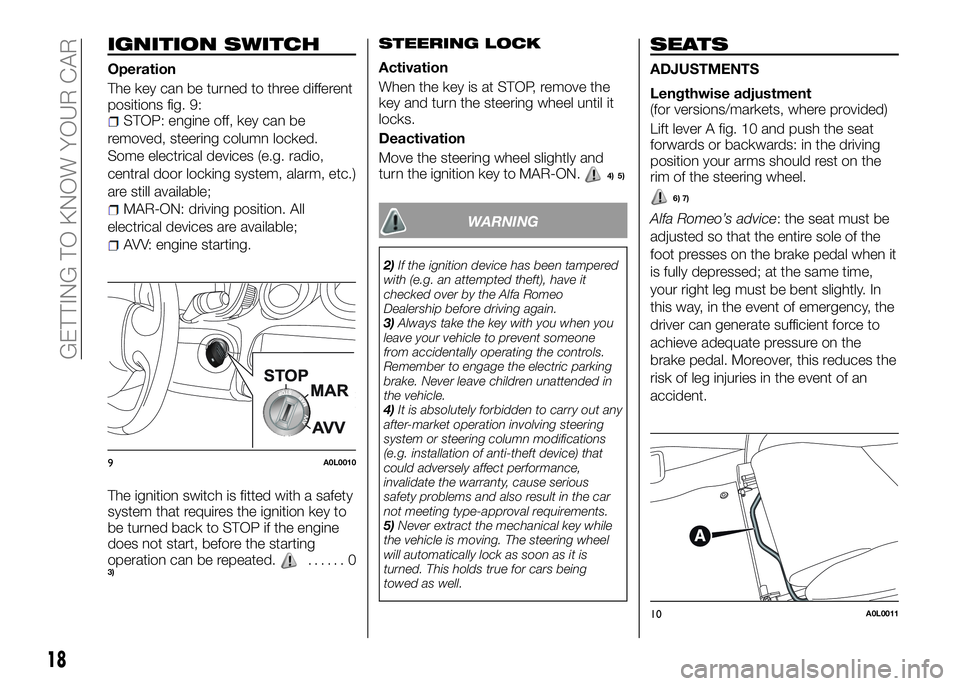
IGNITION SWITCH
Operation
The key can be turned to three different
positions fig. 9:
STOP: engine off, key can be
removed, steering column locked.
Some electrical devices (e.g. radio,
central door locking system, alarm, etc.)
are still available;
MAR-ON: driving position. All
electrical devices are available;
AVV: engine starting.
The ignition switch is fitted with a safety
system that requires the ignition key to
be turned back to STOP if the engine
does not start, before the starting
operation can be repeated.
...... 03)
STEERING LOCK
Activation
When the key is at STOP, remove the
key and turn the steering wheel until it
locks.
Deactivation
Move the steering wheel slightly and
turn the ignition key to MAR-ON.
4) 5)
WARNING
2)If the ignition device has been tampered
with (e.g. an attempted theft), have it
checked over by the Alfa Romeo
Dealership before driving again.
3)Always take the key with you when you
leave your vehicle to prevent someone
from accidentally operating the controls.
Remember to engage the electric parking
brake. Never leave children unattended in
the vehicle.
4)It is absolutely forbidden to carry out any
after-market operation involving steering
system or steering column modifications
(e.g. installation of anti-theft device) that
could adversely affect performance,
invalidate the warranty, cause serious
safety problems and also result in the car
not meeting type-approval requirements.
5)Never extract the mechanical key while
the vehicle is moving. The steering wheel
will automatically lock as soon as it is
turned. This holds true for cars being
towed as well.
SEATS
ADJUSTMENTS
Lengthwise adjustment
(for versions/markets, where provided)
Lift lever A fig. 10 and push the seat
forwards or backwards: in the driving
position your arms should rest on the
rim of the steering wheel.
6) 7)
Alfa Romeo’s advice: the seat must be
adjusted so that the entire sole of the
foot presses on the brake pedal when it
is fully depressed; at the same time,
your right leg must be bent slightly. In
this way, in the event of emergency, the
driver can generate sufficient force to
achieve adequate pressure on the
brake pedal. Moreover, this reduces the
risk of leg injuries in the event of an
accident.
9A0L0010
10A0L0011
18
GETTING TO KNOW YOUR CAR
Page 22 of 182
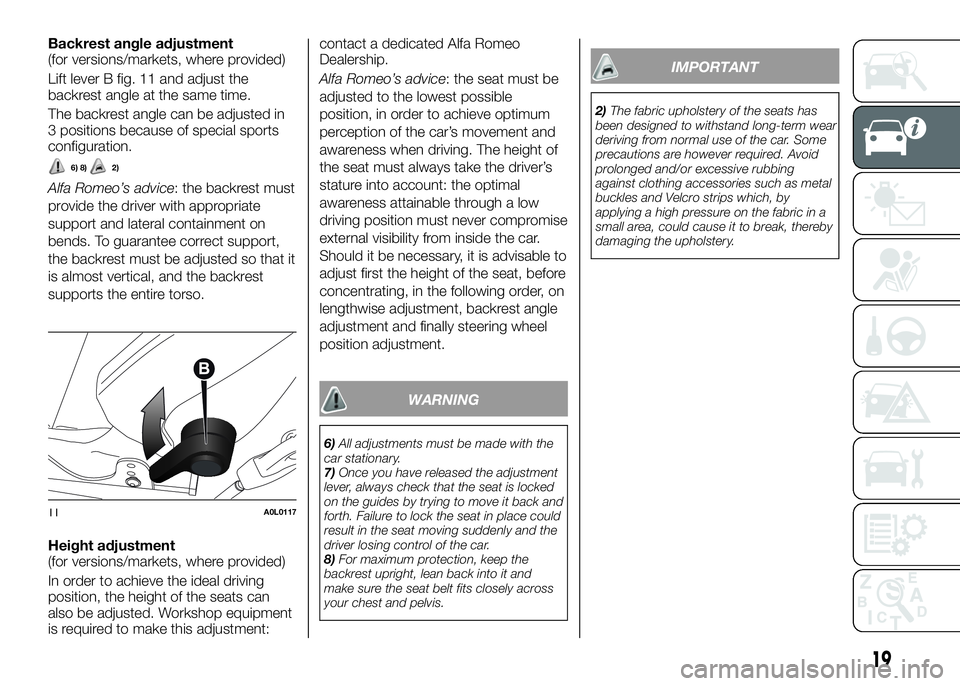
Backrest angle adjustment
(for versions/markets, where provided)
Lift lever B fig. 11 and adjust the
backrest angle at the same time.
The backrest angle can be adjusted in
3 positions because of special sports
configuration.
6) 8)2)
Alfa Romeo’s advice: the backrest must
provide the driver with appropriate
support and lateral containment on
bends. To guarantee correct support,
the backrest must be adjusted so that it
is almost vertical, and the backrest
supports the entire torso.
Height adjustment
(for versions/markets, where provided)
In order to achieve the ideal driving
position, the height of the seats can
also be adjusted. Workshop equipment
is required to make this adjustment:contact a dedicated Alfa Romeo
Dealership.
Alfa Romeo’s advice: the seat must be
adjusted to the lowest possible
position, in order to achieve optimum
perception of the car’s movement and
awareness when driving. The height of
the seat must always take the driver’s
stature into account: the optimal
awareness attainable through a low
driving position must never compromise
external visibility from inside the car.
Should it be necessary, it is advisable to
adjust first the height of the seat, before
concentrating, in the following order, on
lengthwise adjustment, backrest angle
adjustment and finally steering wheel
position adjustment.
WARNING
6)All adjustments must be made with the
car stationary.
7)Once you have released the adjustment
lever, always check that the seat is locked
on the guides by trying to move it back and
forth. Failure to lock the seat in place could
result in the seat moving suddenly and the
driver losing control of the car.
8)For maximum protection, keep the
backrest upright, lean back into it and
make sure the seat belt fits closely across
your chest and pelvis.
IMPORTANT
2)The fabric upholstery of the seats has
been designed to withstand long-term wear
deriving from normal use of the car. Some
precautions are however required. Avoid
prolonged and/or excessive rubbing
against clothing accessories such as metal
buckles and Velcro strips which, by
applying a high pressure on the fabric in a
small area, could cause it to break, thereby
damaging the upholstery.
11A0L0117
19
Page 23 of 182
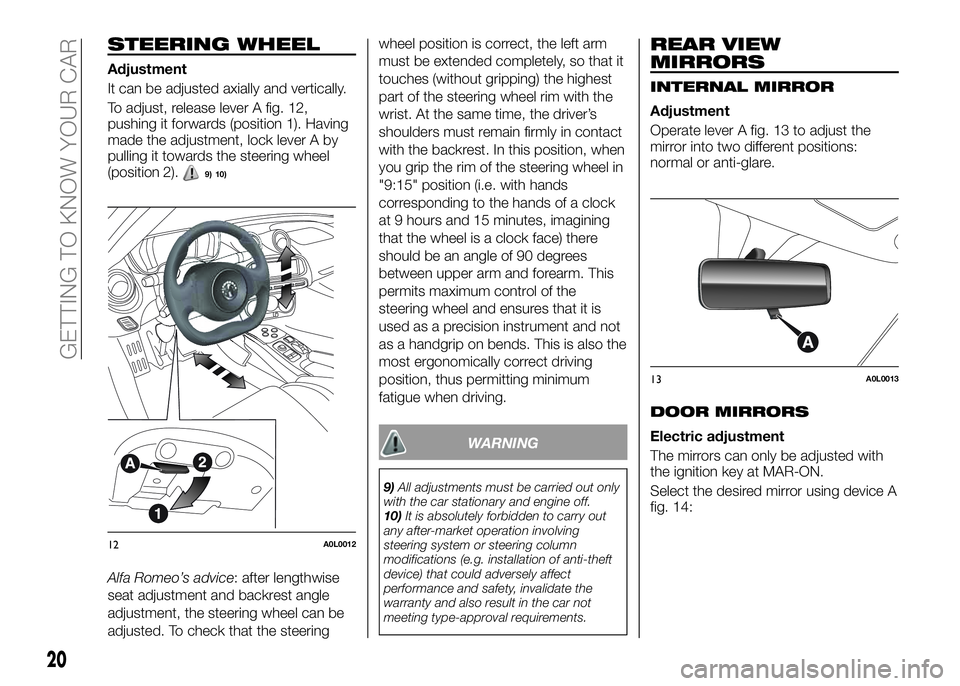
STEERING WHEEL
Adjustment
It can be adjusted axially and vertically.
To adjust, release lever A fig. 12,
pushing it forwards (position 1). Having
made the adjustment, lock lever A by
pulling it towards the steering wheel
(position 2).
9) 10)
Alfa Romeo’s advice: after lengthwise
seat adjustment and backrest angle
adjustment, the steering wheel can be
adjusted. To check that the steeringwheel position is correct, the left arm
must be extended completely, so that it
touches (without gripping) the highest
part of the steering wheel rim with the
wrist. At the same time, the driver’s
shoulders must remain firmly in contact
with the backrest. In this position, when
you grip the rim of the steering wheel in
"9:15" position (i.e. with hands
corresponding to the hands of a clock
at 9 hours and 15 minutes, imagining
that the wheel is a clock face) there
should be an angle of 90 degrees
between upper arm and forearm. This
permits maximum control of the
steering wheel and ensures that it is
used as a precision instrument and not
as a handgrip on bends. This is also the
most ergonomically correct driving
position, thus permitting minimum
fatigue when driving.
WARNING
9)All adjustments must be carried out only
with the car stationary and engine off.
10)It is absolutely forbidden to carry out
any after-market operation involving
steering system or steering column
modifications (e.g. installation of anti-theft
device) that could adversely affect
performance and safety, invalidate the
warranty and also result in the car not
meeting type-approval requirements.
REAR VIEW
MIRRORS
INTERNAL MIRROR
Adjustment
Operate lever A fig. 13 to adjust the
mirror into two different positions:
normal or anti-glare.
DOOR MIRRORS
Electric adjustment
The mirrors can only be adjusted with
the ignition key at MAR-ON.
Select the desired mirror using device A
fig. 14:
12A0L0012
13A0L0013
20
GETTING TO KNOW YOUR CAR
Page 24 of 182
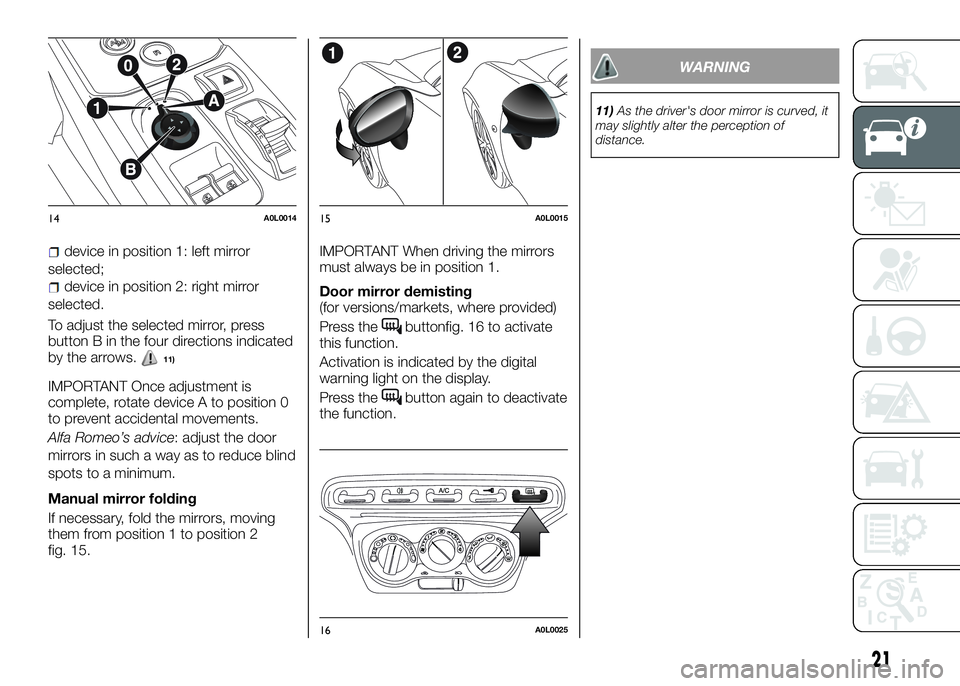
device in position 1: left mirror
selected;
device in position 2: right mirror
selected.
To adjust the selected mirror, press
button B in the four directions indicated
by the arrows.
11)
IMPORTANT Once adjustment is
complete, rotate device A to position 0
to prevent accidental movements.
Alfa Romeo’s advice: adjust the door
mirrors in such a way as to reduce blind
spots to a minimum.
Manual mirror folding
If necessary, fold the mirrors, moving
them from position 1 to position 2
fig. 15.IMPORTANT When driving the mirrors
must always be in position 1.
Door mirror demisting
(for versions/markets, where provided)
Press the
buttonfig. 16 to activate
this function.
Activation is indicated by the digital
warning light on the display.
Press the
button again to deactivate
the function.
WARNING
11)As the driver's door mirror is curved, it
may slightly alter the perception of
distance.
14A0L001415A0L0015
16A0L0025
21
Page 25 of 182
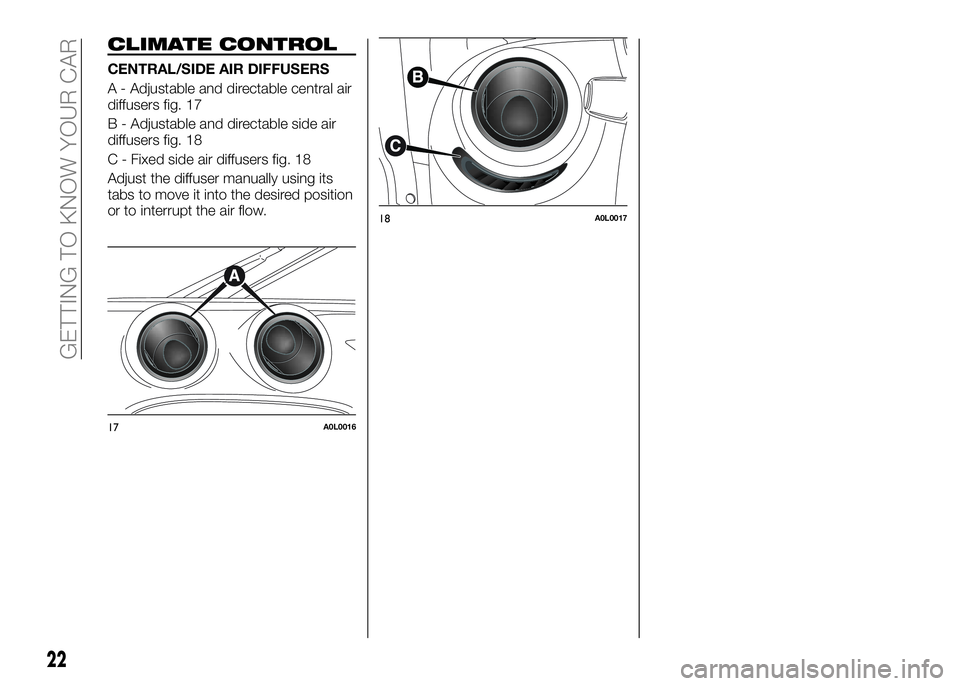
CLIMATE CONTROL
CENTRAL/SIDE AIR DIFFUSERS
A - Adjustable and directable central air
diffusers fig. 17
B - Adjustable and directable side air
diffusers fig. 18
C - Fixed side air diffusers fig. 18
Adjust the diffuser manually using its
tabs to move it into the desired position
or to interrupt the air flow.
17A0L0016
18A0L0017
22
GETTING TO KNOW YOUR CAR
Page 26 of 182
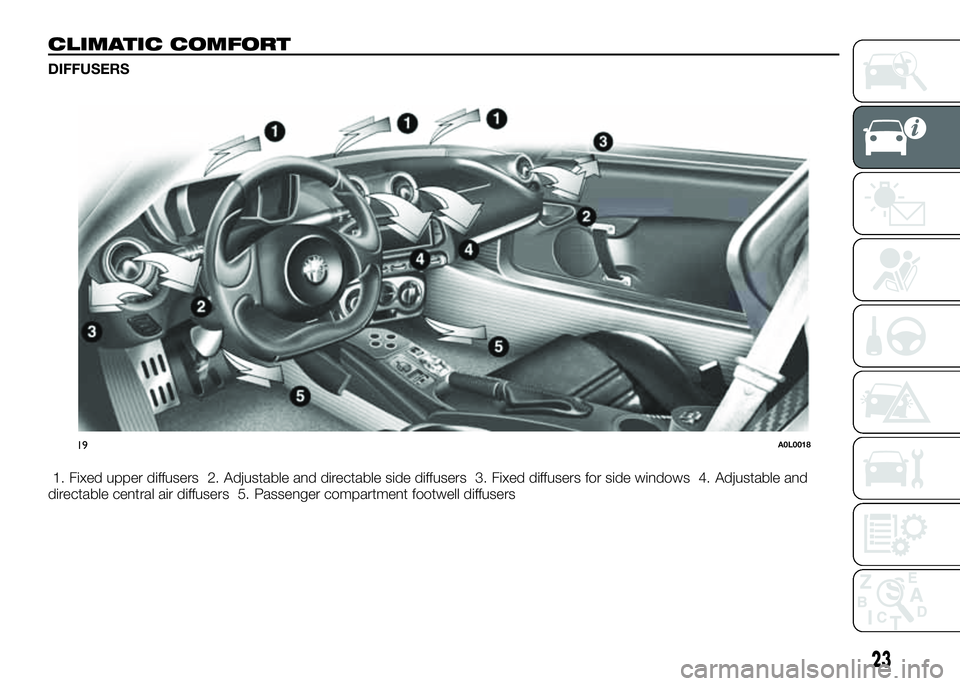
CLIMATIC COMFORT
DIFFUSERS
1. Fixed upper diffusers 2. Adjustable and directable side diffusers 3. Fixed diffusers for side windows 4. Adjustable and
directable central air diffusers 5. Passenger compartment footwell diffusers
19A0L0018
23
Page 27 of 182
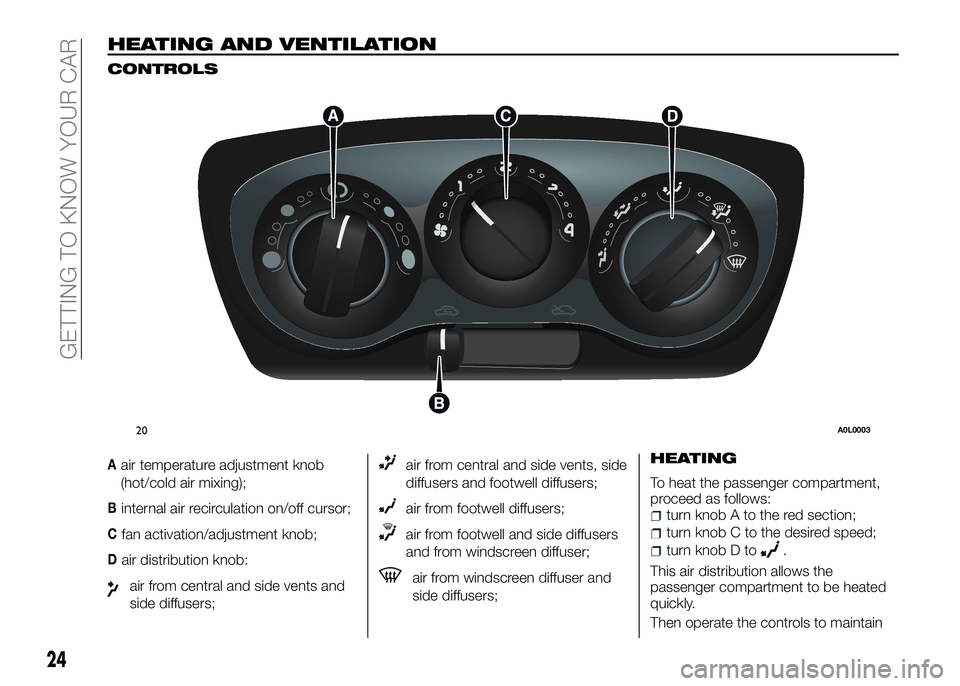
HEATING AND VENTILATION
CONTROLS
Aair temperature adjustment knob
(hot/cold air mixing);
Binternal air recirculation on/off cursor;
Cfan activation/adjustment knob;
Dair distribution knob:
air from central and side vents and
side diffusers;
air from central and side vents, side
diffusers and footwell diffusers;
air from footwell diffusers;
air from footwell and side diffusers
and from windscreen diffuser;
air from windscreen diffuser and
side diffusers;HEATING
To heat the passenger compartment,
proceed as follows:
turn knob A to the red section;
turn knob C to the desired speed;
turn knob D to.
This air distribution allows the
passenger compartment to be heated
quickly.
Then operate the controls to maintain
20A0L0003
24
GETTING TO KNOW YOUR CAR
Page 28 of 182
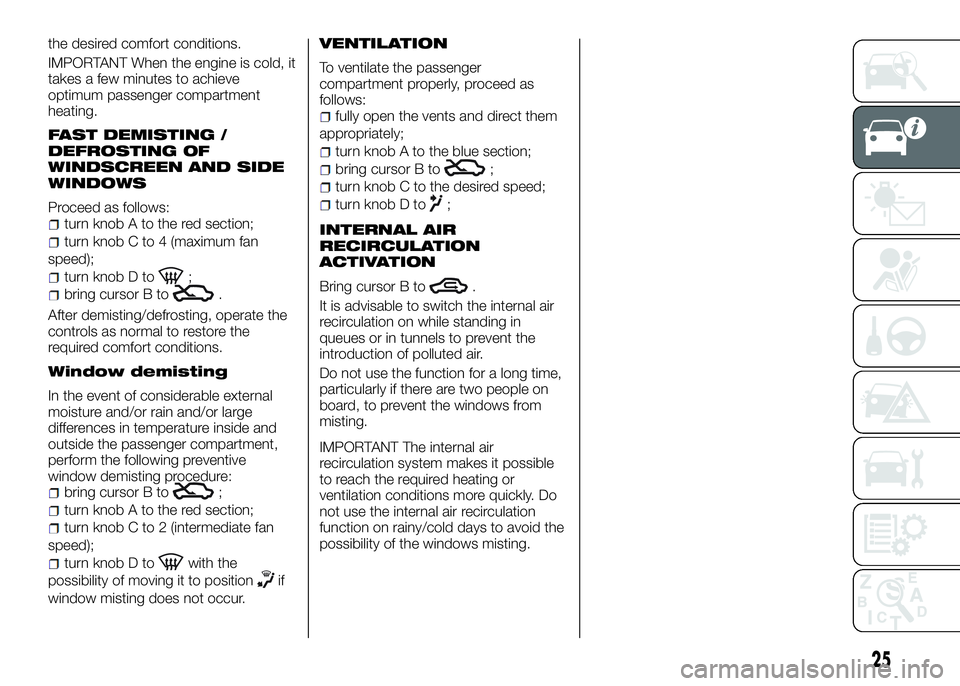
the desired comfort conditions.
IMPORTANT When the engine is cold, it
takes a few minutes to achieve
optimum passenger compartment
heating.
FAST DEMISTING /
DEFROSTING OF
WINDSCREEN AND SIDE
WINDOWS
Proceed as follows:turn knob A to the red section;
turn knob C to 4 (maximum fan
speed);
turn knob D to;
bring cursor B to.
After demisting/defrosting, operate the
controls as normal to restore the
required comfort conditions.
Window demisting
In the event of considerable external
moisture and/or rain and/or large
differences in temperature inside and
outside the passenger compartment,
perform the following preventive
window demisting procedure:
bring cursor B to;
turn knob A to the red section;
turn knob C to 2 (intermediate fan
speed);
turn knob D towith the
possibility of moving it to position
if
window misting does not occur.
VENTILATION
To ventilate the passenger
compartment properly, proceed as
follows:
fully open the vents and direct them
appropriately;
turn knob A to the blue section;
bring cursor B to;
turn knob C to the desired speed;
turn knob D to;
INTERNAL AIR
RECIRCULATION
ACTIVATION
Bring cursor B to.
It is advisable to switch the internal air
recirculation on while standing in
queues or in tunnels to prevent the
introduction of polluted air.
Do not use the function for a long time,
particularly if there are two people on
board, to prevent the windows from
misting.
IMPORTANT The internal air
recirculation system makes it possible
to reach the required heating or
ventilation conditions more quickly. Do
not use the internal air recirculation
function on rainy/cold days to avoid the
possibility of the windows misting.
25
Page 29 of 182
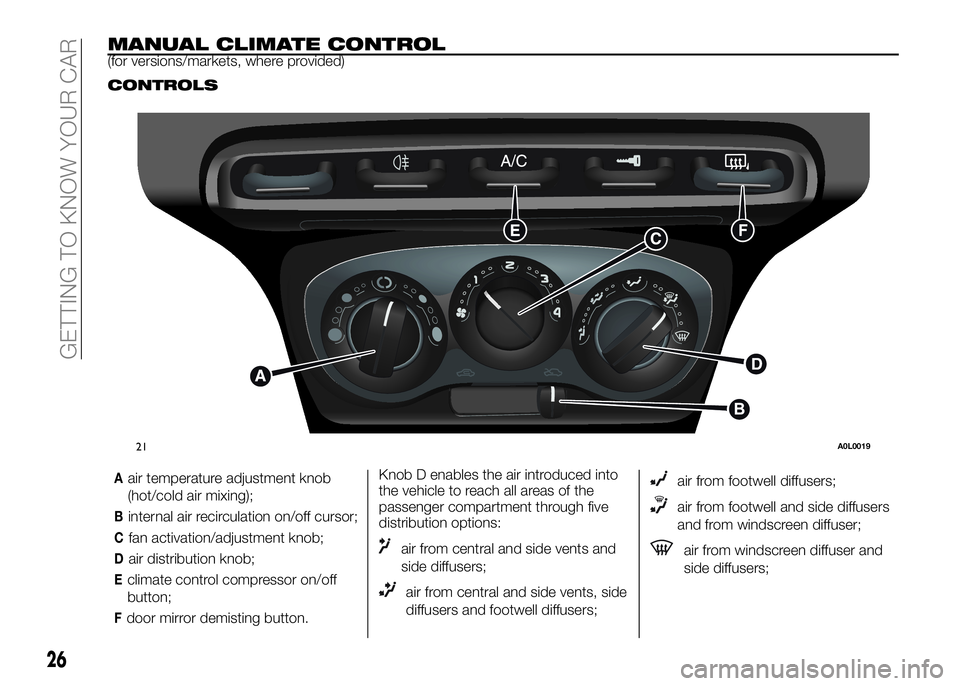
MANUAL CLIMATE CONTROL(for versions/markets, where provided)
CONTROLS
Knob D enables the air introduced into
the vehicle to reach all areas of the
passenger compartment through five
distribution options:
air from central and side vents and
side diffusers;
air from central and side vents, side
diffusers and footwell diffusers;
air from footwell diffusers;
air from footwell and side diffusers
and from windscreen diffuser;
air from windscreen diffuser and
side diffusers;
21A0L0019
26
GETTING TO KNOW YOUR CAR
Aair temperature adjustment knob
(hot/cold air mixing);
Binternal air recirculation on/off cursor;
Cfan activation/adjustment knob;
Dair distribution knob;
Eclimate control compressor on/off
button;
Fdoor mirror demisting button.
Page 30 of 182
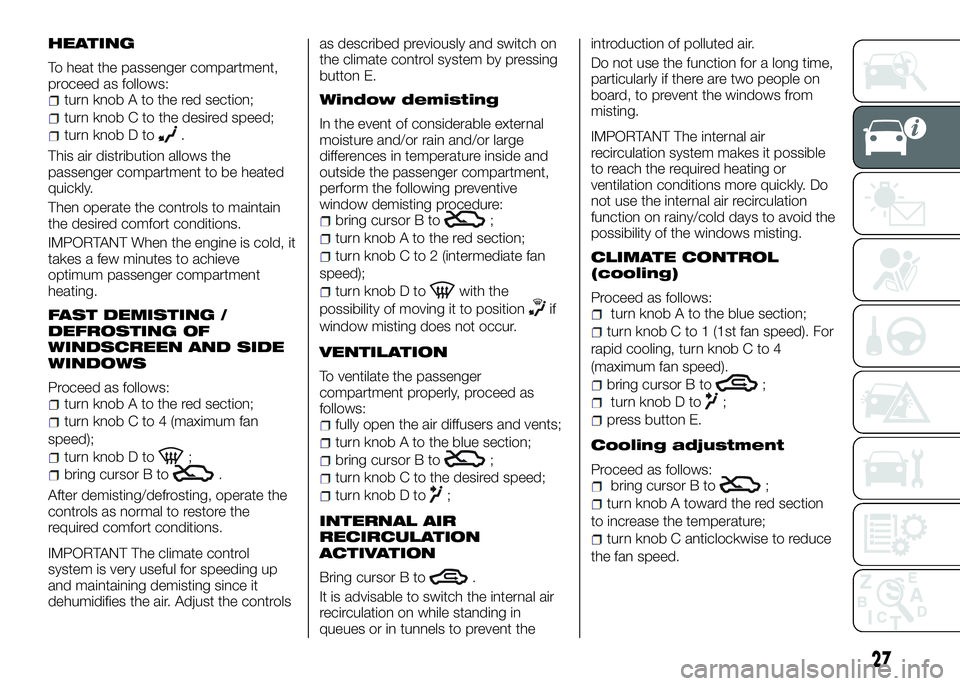
HEATING
To heat the passenger compartment,
proceed as follows:
turn knob A to the red section;
turn knob C to the desired speed;
turn knob D to.
This air distribution allows the
passenger compartment to be heated
quickly.
Then operate the controls to maintain
the desired comfort conditions.
IMPORTANT When the engine is cold, it
takes a few minutes to achieve
optimum passenger compartment
heating.
FAST DEMISTING /
DEFROSTING OF
WINDSCREEN AND SIDE
WINDOWS
Proceed as follows:turn knob A to the red section;
turn knob C to 4 (maximum fan
speed);
turn knob D to;
bring cursor B to.
After demisting/defrosting, operate the
controls as normal to restore the
required comfort conditions.
IMPORTANT The climate control
system is very useful for speeding up
and maintaining demisting since it
dehumidifies the air. Adjust the controlsas described previously and switch on
the climate control system by pressing
button E.
Window demisting
In the event of considerable external
moisture and/or rain and/or large
differences in temperature inside and
outside the passenger compartment,
perform the following preventive
window demisting procedure:
bring cursor B to;
turn knob A to the red section;
turn knob C to 2 (intermediate fan
speed);
turn knob D towith the
possibility of moving it to position
if
window misting does not occur.
VENTILATION
To ventilate the passenger
compartment properly, proceed as
follows:
fully open the air diffusers and vents;
turn knob A to the blue section;
bring cursor B to;
turn knob C to the desired speed;
turn knob D to;
INTERNAL AIR
RECIRCULATION
ACTIVATION
Bring cursor B to.
It is advisable to switch the internal air
recirculation on while standing in
queues or in tunnels to prevent theintroduction of polluted air.
Do not use the function for a long time,
particularly if there are two people on
board, to prevent the windows from
misting.
IMPORTANT The internal air
recirculation system makes it possible
to reach the required heating or
ventilation conditions more quickly. Do
not use the internal air recirculation
function on rainy/cold days to avoid the
possibility of the windows misting.
CLIMATE CONTROL
(cooling)
Proceed as follows:turn knob A to the blue section;
turn knob C to 1 (1st fan speed). For
rapid cooling, turn knob C to 4
(maximum fan speed).
bring cursor B to;
turn knob D to;
press button E.
Cooling adjustment
Proceed as follows:bring cursor B to;
turn knob A toward the red section
to increase the temperature;
turn knob C anticlockwise to reduce
the fan speed.
27